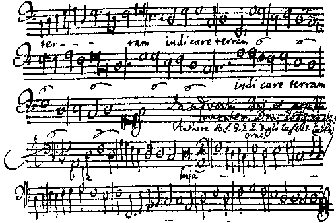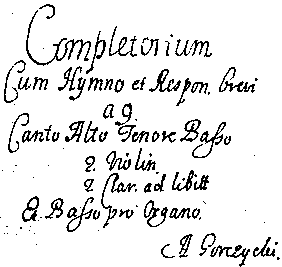|
POLISH EARLY MVSIC |
Composers | Essays | Sources | Feedback | Editorial |
Grzegorz Gerwazy Gorczycki (1667? - 1734)
Well. This is one of my favorite composers.
Here is what Włodzimierz Sołtysik, a musicologist, conductor and vocalist, writes about him:
"Up until Second World War, Grzegorz Gerwazy Gorczycki was considered one of a group of outstanding though conservative Polish composers of the Baroque. The research done by musicologists after the war brought to light many of Gorczycki's unknown works of fine quality, turned up information concerning his work and facts of the composer's life that contribute immeasurably to the composer's stature and importance in the history of Polish music.
Grzegorz Gerwazy Gorczycki was born about the year 1665 in a family of free peasants. His father, Adam Gorczica, was a wealthy landowner and head man of the village of Rozbark outside of Bytom. Nothing is known of the early period of his life. Nor is anything known where he acquired his expert knowledge of music and excellent composing technique. Evidence is available regarding his studies at the Academy of Czech Prague and at the University of Vienna where he received a doctorate in Liberal Arts and Philosophy. It is assumed that after attending Cracow's Catholic Seminary for a time, he then continued his studies in Prague and Vienna. It is also assumed that he studied music while abroad. Upon his return to Poland and a brief period at the Wawel Seminary in Cracow, he was ordained in March 22, 1692.
 He soon attracted attention thanks to his erudition and musical
accomplishments as may be
witnessed by the fact that directly upon being ordained he received an important appointment
as director of the academy of missionary priests at Chełmno, Pomerania. He was described as vir sedatus, literatus, artis musicae peritissimus. He also acted as professor of rhetoric and poetics and conducted the local orchestra.
He soon attracted attention thanks to his erudition and musical
accomplishments as may be
witnessed by the fact that directly upon being ordained he received an important appointment
as director of the academy of missionary priests at Chełmno, Pomerania. He was described as vir sedatus, literatus, artis musicae peritissimus. He also acted as professor of rhetoric and poetics and conducted the local orchestra.
Two years later Gorczycki returned to Cracow where he performed the office of curate at the cathedral and performed in the cathedral orchestra. In 1698 he was appointed conductor of the cathedral ensemble. Gorczycki carried out his duties as Kapellmeister of the group to the end of his life in April 30, 1734.
Gorczycki enjoyed enormous prestige and fame even during his life,
for two years after his death a laudatory monograph was devoted to him by Józef M. Nogawski. He was not an excellent composer
but also a very fine person. Goczycki's personality appears to best advantage in the light of available
information and archival material. He is described as a man of unbounded energy, hard working and conscientious.
He was a conductor of several ensembles, a copyist, teacher and seminary examiner.
He was also active in such social services as caring of the sick in the hospital and prison,
acted as a Penitentiary and was known for his charitable work as administrator of the
God's Mercy Church at Cracow's Smoleńsk district, making an especially valuable contribution
in days of disaster and epidemics.
During the Swedish invasion of Cracow, he was one of the few priests to remain at his post.
The said author of his monograph, Nogawski, included in the translation of sermons that he brought
out a panegyric dedicated to Gorczycki from which we learn about the composer's travel
to Rome. Gorczycki remained a cult figure in Cracow and his compositions were performed
to most recent times.
The earliest information about Gorczycki's compositions come from 1694. By 1698 the composer must have already written a substantial number of works since the Wawel Cathedral Chapter appointed him conductor of the orchestra as artis Musices gnarum et compositorem. Gorczycki's talents were at their peak in the early 18th century. Unfortunately, since none of his compositions appeared in print during his life, many of them have now been lost. First time Gorczycki's composition, Missa Paschalis, (Kyrie; Gloria; Sanctus; Benedictus; Agnus Dei - A.J.), was published in 1839 by J. Cichocki. Latest research has established that manuscripts of his compositions were found in Częstochowa, Raków, Sandomierz, Warsaw, Wieluń and Podoliniec (Slovakia). We now have information about nearly 50 of Gorczycki's compositions.
As said earlier, until quite recently, historians judged Gorczycki to be an outstanding but conservative composer of works written mainly in the a capella tradition. The latest discoveries indicate that his work evolved along many lines as evidenced by compositions a capella, vocal-instrumental compositions, works for instruments alone and perhaps also stage works.
The first and richest strand of Gorczycki's work is represented by four-parts compositions for mixed choir a capella or with the accompaniment of a small instrumental ensemble (2 Violini, Organo). These are usually in the Palestrinian tradition, prima practica. This style, characteristic of the Polish Baroque, bore a relation to the Renaissance in the sense of the expression of a certain stylization. Gorczycki revealed himself as a pastmaster with a thorough grounding in the counterpointing technique. His masses, his arrangements of the antiphons, hymns, introits, offertories belong to this category. His cantus firmus technique was marked by a striking originality. This fixed tune is taken from the plainchant although it may also come from popular religious songs. We find here a whole gamut of polyphonic devices. The finest works in this form are his Missa paschalis (see above - A.J.), Sepulto Domino and Tota pulchra es Maria. Post-war research added six formerly unknown compositions to the list. (including Dignare me laudare te. Other popular composition in this style is Ave Maria - A.J.)
 The second strand of Gorczycki's output are vocal-instrumental
compositions in the then current
concertante style. The motet Illuxit sol has some features of that style, but it is
seen in its full flower in the concertante pieces discovered in the post war years:
Laetatus sum, In virtute tua (We used to sing this motet together with Mozart's Venite populi, which in turn seemed to us pretty bland in comparison - A.J.), Litaniae de Providentia Divina,
Conductus funebris and Completorium (Cum
invocarem, In te, Domine, speravi and 5 more movements - A.J.)
The second strand of Gorczycki's output are vocal-instrumental
compositions in the then current
concertante style. The motet Illuxit sol has some features of that style, but it is
seen in its full flower in the concertante pieces discovered in the post war years:
Laetatus sum, In virtute tua (We used to sing this motet together with Mozart's Venite populi, which in turn seemed to us pretty bland in comparison - A.J.), Litaniae de Providentia Divina,
Conductus funebris and Completorium (Cum
invocarem, In te, Domine, speravi and 5 more movements - A.J.)
Music for instruments forms the third strand of Gorczycki's work. Though modest in scope, it is a documented fact. In 1962 Jan Prosnak published information about a new composition by Gorczycki that had been discovered recently, namely the Ball Polonaise. Regrettably, only the violin part has been found, now carefully preserved in the Jelski family archives. However, it is known that a Polonaise for instruments by Gorczycki was performed by the entire orchestra at Marshal Rokicki's residence at Horodyszcze. This is the first known report of a secular and purely instrumental piece by the composer. But, in view of his achievements in religious music, this seemed highly improbable. However, the catalogue of the Wieluń Piarists published a year later confirmed the fact. It appears that the orchestra of Wieluń also had Gorczycki's Ouverture ex D in its repertory.
Thus, in the light of the research and discoveries made in archives, Gorczycki reveals himself not only as a master composer but also a highly versatile artist who deliberately chose to write conservative polyphonic and a capella pieces although he was highly proficient in the Baroque concerto style of his time and did not shun writing music for instruments.
The assertions of 19th century researchers about his music dramas and songs is finding strong confirmation. He is revealing himself as a towering figure in vocal music a capella, as well as in concertante, vocal and instrumental compositions. For this reason Grzegorz Gerwazy Gorczycki should be hailed today as one of the best composers of Early Polish Music."
From the Keeper: Let's have a closer look at some dates:
Bear in mind, please, that these are definitely not some small, dusted pieces interesting only to the musicologists around. These compositions stand among the very best Polish Baroque music and no need (IMHO) to be ashamed of them when comparing these pieces to other European music of that period. There are still some uncharted regions in Polish early music to be discovered, and I'm eagerly waiting for more revelations to appear.
Of Gorczycki compositions, at least 46 survived. The following list has been completed for the current update of the site.